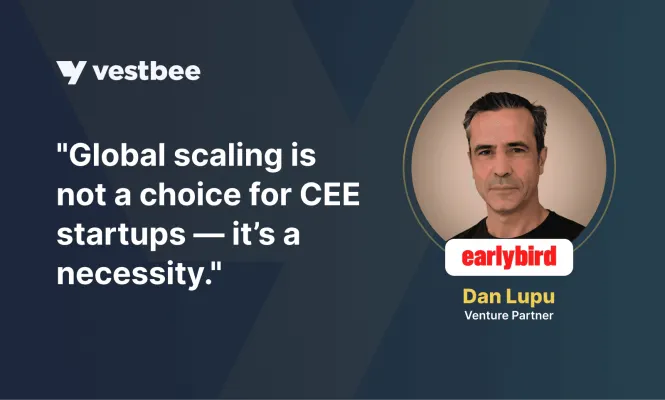Dan Lupu, Venture Partner at Earlybird, asserts that global scaling is not merely an option but a necessity for startups originating in Central and Eastern Europe. His foresight was evident in 2015 when, as part of Earlybird Digital East (now Bek Ventures), he was involved in the early investment in UiPath, recognizing the vast potential of automation well before it became mainstream. Today, Lupu emphasizes the importance of founders possessing a “global DNA” — a mindset geared towards international markets from the outset. This perspective is crucial in a region where local markets often lack the scale to support billion-euro enterprises.
In our interview, Dan Lupu shared his insights on the traits that define globally-minded founders, the evolving perception of CEE entrepreneurs on the international stage, and some useful strategies startups need to scale beyond their home markets.
UiPath was one of the Digital East Fund’s most successful early bets. What made you see its potential so early on?
I met Daniel Dines back in 2015 through a friend. When I saw the first iteration of their demo, it hit me that this was like a “record macro” from Excel made for applications, and I could understand how this would help automate business processes. I would be lying if I told you I could see the potential of the company going public, but I could see that the problem space was big, and hence, the market size would be too. That’s what sparked my conviction in the idea and the team.
I led the investment in UiPath and was its first investor, staying on the board until the IPO. That’s what we mean when we talk about being “all in from day one” at Earlybird. I brought Credo on board, who then brought in Seedcamp, and from there, the market took off. Its structure was conducive to an outsized return because there was no Microsoft, Oracle, or IBM as we know them today. Basically, the companies that were still bigger than UiPath at the time were not gorillas in the room. They had maybe 10, 15, 20 million in revenues, not billions.
In the end, the outcome of any investment depends less on the investors and more on the specific entrepreneur driving the company. Daniel had the drive to create a big company, to have it listed and publicly traded. He wanted to do this, and he achieved it.
What traits matter most to you in founders — mindset, approach, tech, or all of them?
Obviously, there needs to be a fit between the founder and the market. Founders who are doing B2B are not a good fit for consumer markets. That’s the top-level sort, but then, there must be an affinity between the founder and the specific sector.
When we look at this, we look for people who are driven and then assess how they intend to channel it. We need to understand the motivation of the founders we invest in: what was their journey? Why are they motivated? & Why would they lose motivation? We have to recognize that the impact of one person is often the make-or-break.
In some interviews, you mentioned looking for founders with a “global DNA”. What does that mean to you, exactly?
Global DNA means founders recognizing that local markets will not help them build global companies. For a fund the size of ours, we need to produce several billion-plus outcomes, and that almost always requires a global approach to markets.
This means, as a founder, you need to source and have a presence in various markets, ideally across multiple continents. So it has to be Europe and Asia, or Europe and the US, more typically. You need the drive to go and make deals internationally and engage with completely unfamiliar business environments. That includes regulatory frameworks, business practices, and — importantly — the cultural element.
Shifting the angle to the global perception of CEE founders: has it changed since 2015? How are they viewed today?
After the success of UiPath and ElevenLabs, people now recognize that there’s real value in CEE-based companies. Technically, there’s no doubt they’re strong. Their product breadth is often broader than you’d see in the US.
Take FintechOS, for example, it competes in Eastern Europe, the UK, and the US, across both insurtech and fintech. In contrast, US companies can thrive in narrow verticals — like credit unions in Western Montana — because there might be a thousand of them, enough to build a unicorn. But in Eastern Europe, local markets are too small to build unicorns, so companies must step out of their comfort zones and build products with a broader reach.
Recent Dealroom data shows an increasing relocation trend: 50% of CEE scaleups have moved, mainly to the US. What does this mean for the region’s future?
That’s not just due to the lack of growth capital in the region. You also need to chase your clients. FintechOS moved to the UK because the market there is much bigger than in CEE, not just in terms of the number of institutions but also their size. That directly impacts your annual contract value, which is also higher.
They still have development teams and some other resources across CEE, but if you want go-to-market or marketing resources, which are fairly scarce in CEE, you need them closer to your clients. At the same time, if your customer success manager needs to chat about the latest Chelsea game with the CTO of Barclays or HSBC to build personal rapport, you can’t do that from CEE. That ability to create personal contact matters.
Do you think it’s still viable to maintain R&D or local offices in the countries of origin while expanding elsewhere?
Yes, it’s important, and usually, this is what happens. The question then becomes how much you can scale in the countries of origin. We like to think we have an endless supply of talented engineers, but that’s not the case. Once your development teams reach a certain size, you need to go out and acquire different kinds of talent that aren’t available locally.
In your opinion, does the relocation of scaleups affect local ecosystem development?
I wouldn’t say that. The success of UiPath, which was listed on the stock exchange, actually sparked further company creation. More people were motivated to try because they had a clear example: yes, it can be done from Romania.
If they had stayed local, they might have remained a minor regional player. So, the success of someone moving out and proving it’s possible — that’s what inspires others to create new companies, which has the most important and positive effect on the ecosystem.
What’s the biggest mistake CEE founders make when scaling globally, and what advice would you give them?
The most common mistake is avoiding the go-to-market process. They think they can just hire someone and outsource it. This often leads to disaster. They hire a professional, often a native English speaker, and trust them completely. But that person typically does a poor job because they’re a hired gun, not a founder. Without proper supervision, six months later, they realize they’re in trouble. It takes another six months to fire that person and take back control. My advice is that you can’t outsource it — you must stay in control. I’m a big fan of founder-led sales, even beyond five million in ARR. It’s something you need to manage yourself until you’re able to teach others how to do it properly.
UPD.: Following the publication of the interview, we received a comment from Bek Ventures. We are publishing it in full, without any edits:
"Digital East Fund, now Bek Ventures, was one of three flagship funds in the confederation of funds under the Earlybird name from 2013 to 2024, alongside Earlybird Digital West and Earlybird Health, and invested in UiPath in 2015. Digital East Fund always operated as an independent entity with its own distinctive investment approach. Dan Lupu was a member of the investment team at the Digital East Fund at the time of the initial UiPath investment, however he has not been an active investor with DEF since 2022. The rest of the investment team that worked on the UiPath investment and all the firm’s other investments remains with the firm, which is now known as Bek Ventures, after rebranding in November, 2024."







